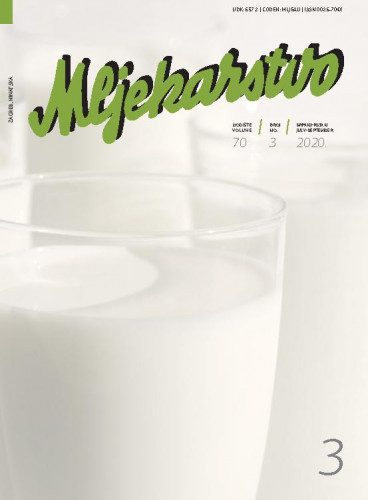In this study volatile compounds and sensory properties of butter produced from cream or yogurt using Lactococcus lactis subsp. lactis biovar. diacetylactis or Leuconostoc mesenteroides subsp. cremoris as well as a mixture of these two bacteria were investigated over 60 days. A total of 10 esters, 6 aldehydes, 11 ketones, 16 alcohols, 6 acids, 2 sulphides, 3 terpenes, and 3 miscellaneous compounds were detected. There were more volatile compounds in cream butter than in yogurt butter. While S-methyl thioacetate was only found in yogurt butter samples, hexanal, ethanol, 2-nonanone, 2-pentanone, 2-heptanone, acetic, butanoic (butyric) and hexanoic acid were the most abundant volatiles in both cream and yogurt butter. The results showed that the use of starter in the manufacturing of yogurt butter, which is traditionally produced without starters, affected the volatile compounds and sensory properties. The highest general acceptability scores were given to the butter samples containing mixed cultures at the end of storage.; U ovom istraživanju ispitivan je utjecaj starter kulture na hlapive sastojke i senzorska svojstva maslaca proizvedenog od vrhnja, odnosno od jogurta tijekom 60 dana hladnog skladištenja. Kao starter kulture korišteni su sojevi Lactococcus lactis subsp. lactis biovar. diacetylactis, Leuconostoc mesenteroides subsp. cremoris te njihova kombinacija. Utvrđeno je formiranje ukupno 10 estera, 6 aldehida, 11 ketona, 16 alkohola, 6 kiselina, 2 sulfida, 3 terpena i 3 atipična sastojka. U pravilu je maslac od vrhnja sadržavao više hlapivih sastojaka nego maslac od jogurta. Prisutnost S-metil tioacetata utvrđena je samo u maslacu od jogurta, dok su u maslacu od vrhnja bili prirodno prisutni heksanal, etanol, 2-nonanon, 2-pentanon, 2-heptanon, acetat, maslačna i kapronska kiselina. Iako se maslac od jogurta inače proizvodi bez startera, dobiveni rezultati su pokazali kako bi korištenje starter kultura u proizvodnji ovog tipa maslaca pozitivno utjecalo na stvaranje hlapivih sastojaka te na njegova senzorska svojstva. Maslac proizveden korištenjem kombinirane starter kulture dobio je najviše ocjene za prihvatljivost.
Sažetak

 Mljekarstvo.com : časopis za unaprjeđenje proizvodnje i prerade mlijeka : 70,3(2020) / glavna i odgovorna urednica, editor in chief Rajka Božanić.
Mljekarstvo.com : časopis za unaprjeđenje proizvodnje i prerade mlijeka : 70,3(2020) / glavna i odgovorna urednica, editor in chief Rajka Božanić.